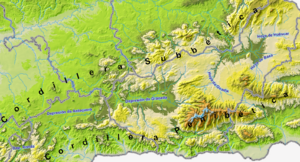Surco Intrabético facts for kids
The Intrabaetic Basin (also known as Surco Intrabético or Depresión Intrabética in Spanish) is a chain of connected valleys in the Baetic System mountain range in Andalusia, Spain. These valleys aren't one long, continuous stretch but rather a series of separate basins linked together.
Contents
What is the Intrabaetic Basin?
The Intrabaetic Basin is made up of several intermontane basins. These are like large, flat areas or valleys found between mountains. They act as a natural border, separating the Penibaetic System mountains to the south from the Subbaetic System mountains to the north.
Where are the Valleys Located?
These valleys stretch across Andalusia, generally running alongside the Mediterranean coast. Together, they form a natural pathway. This path connects western Andalusia and the Guadalquivir river valley to the Spanish Levante, which is the eastern coastal region of Spain.
The main valleys that form the Intrabaetic Basin are:
- The Depression of Ronda
- The Hoya of Antequera
- The Depression of Granada
- The Hoya of Guadix
- The Hoya of Baza
- The Hoya of Huéscar
- The Hoya of Lorca
What are the Valleys Made Of?
Unlike the nearby rocky mountains, which are often made of hard limestone and have little plant life, the valleys of the Intrabaetic Basin are different. They are formed from softer materials like clays, silts, and conglomerates (which are rocks made of smaller, rounded pebbles cemented together).
The soils in these valleys are deep and good for farming. However, a big challenge for people living here is the lack of water.
How Did the Basin Form?
The Intrabaetic Basin started to form a very long time ago, at the end of the Oligocene epoch and the beginning of the Miocene epoch. This was when the Baetic mountain ranges themselves were being created.
Scientists believe that back then, the entire Baetic mountain system was surrounded by water. The basin was likely one large, continuous valley, sometimes called the Baetic Depression. Over time, rocky spurs (like small mountain ridges) rose up across this valley. These spurs divided the single large valley into the series of separate valleys we see today.
Different Parts of the Basin
Even though all parts of the Intrabaetic Basin are sedimentary basins (meaning they formed from layers of sediment), they are quite varied:
- The Depression of Ronda is the westernmost valley and is completely within the Penibético mountain range.
- The Hoya of Antequera has a close connection to the original Baetic Depression. It used to be a large gulf of the sea that separated the Sierra Morena mountains from the Andalusian ranges.
- The Depression of Granada is located between the Penibético and Subbético ranges.
- The Hoyas of Guadix, Baza, and Huéscar are more closely linked to the Subbético range.
Travel and Connections
The Intrabaetic Basin provides an important route for travel. The Autovía A-92 highway uses this path to connect major cities like Seville to Almería. Along the way, it passes through Antequera, Granada, and Guadix.
A branch of this highway, the Autovía A-92N, goes through Cúllar and Baza before reaching Puerto Lumbreras. There, it connects with the Autovía A-7, which continues on to Murcia and the Spanish Levante region.
See also
- Baetic System
- Geography of Spain
- Geology of the Iberian Peninsula
 In Spanish: Surco Intrabético para niños
In Spanish: Surco Intrabético para niños


